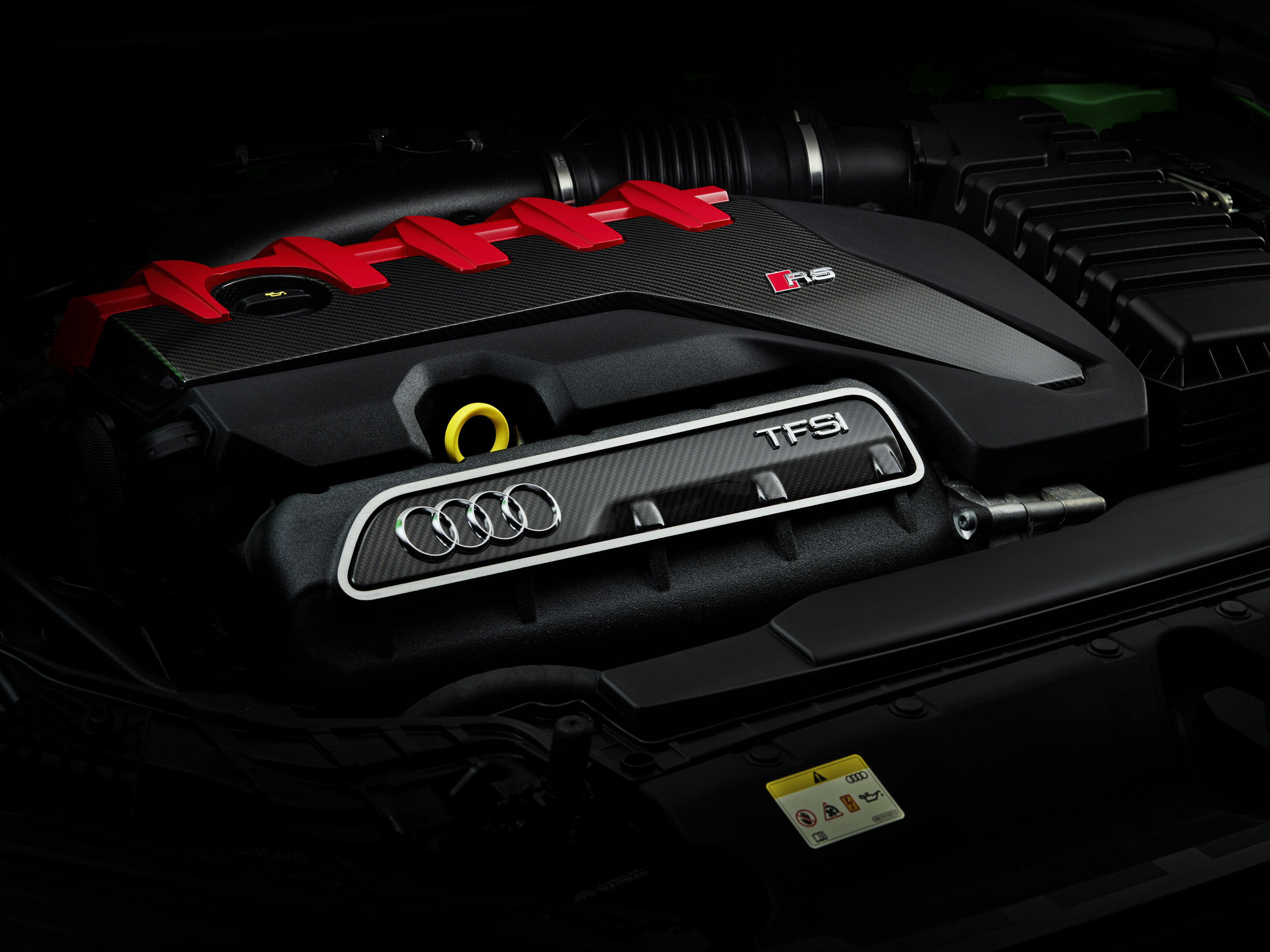The ENGINE: legendary five-cylinder
Back to overviewThe five-cylinder engine manufactured by the brand with the four rings has long since achieved legendary status and perfectly embodies the Audi DNA. Countless victories in motorsports and strong performance in day-to-day use have earned the five-cylinder engine the “International Engine of the Year Award” nine times in succession since 2010. The 2.5 TFSI has played a key role in shaping Audi’s “Vorsprung durch Technik.” The engine provides a highly emotional driving experience with its typical 1-2-4-5-3 firing order and the associated throaty sound. In the new RS 3 models, it further extends its lead over the competition.
More powerful: 20 newton meters more torque
The five-cylinder in the new RS 3 delivers 294 kW (400 PS), which extends from 5,600 rpm over a broad plateau to 7,000 rpm. This means that the engine’s maximum power is available 250 revolutions earlier than before and correspondingly longer. In other words, the power curve is steeper. In addition, the engineers have enhanced the angle drive and increased the torque of the 2.5 TFSI by 20 Nm to 500 newton meters. It ranges from 2,250 and 5,600 rpm. Despite the same power output as its predecessor, the five-cylinder engine has more pull, particularly in the low to medium rev ranges, and accelerates better. The new RS 3 sprints from 0 to 100 km/h three tenths of a second faster with Launch Control standard – 3.8 seconds now appear in the data table.
As an option, Audi can raise the electronically limited maximum speed from 250 km/h (155 mph) to 280 km/h (174 mph). With the RS dynamics package plus, which includes the ceramic brake system and adaptive suspension, 290 km/h is even possible. The acceleration and top speed of the Audi RS 3 are thus the benchmark in the compact segment.
A 7-speed dual-clutch transmission is what puts the power of the five-cylinder engine to the pavement – with shorter shifting times and sporty gear ratios. Drivers can set the S tronic, which shifts at lightning speed, to automatic D and S gears or shift manually using the paddle shifters on the steering wheel. Together with the new, faster onboard power system, the new engine control unit intelligently manages the interaction between the quattro drive system including torque splitter, the dual-clutch transmission, electronic stabilization control, and the optional adaptive dampers.
| Audi RS 3 | 2.5 TFSI |
| Displacement in cm3 | 2,480 |
| Max. power in kW (PS) at /min | 294 (400) at 5,600 – 7,000 |
| Max. torque inNm at /min | 500 at 2,250 – 5,600 |
| Top speed in km/h | 250, optionally 280 and 290 with RS dynamics |
| Acceleration from 0 to 100 km/h in s | 3.8 |
| Combined fuel consumption in l/100 km | 8.8 – 8.3 (Sportback) |
| Combined CO2 emissions in g/km | 201 – 190 (Sportback) |
| Transmission | 7-speed S tronic, quattro permanent all-wheel drive with torque splitter |
The abbreviation TFSI denotes turbocharging and direct injection – a combination that Audi was the first carmaker in the world to bring to large-scale production in 2004. The exhaust gas turbocharger in the new RS 3 generates 1.5 bars of boost pressure (relative). Complex measures reduce internal friction while increasing power output. Lightweight materials are used for many engine components. The oil pan, for example, is made of magnesium, while the crankcase of the 2.5 TFSI is made of aluminum. The cylinder barrels are plasma-coated, the crankshaft is hollow-bored, and the aluminum pistons have channels for oil cooling. In the short warm-up phase after a cold start, the switchable water pump does not circulate the coolant in the cylinder head – in this way, the 2.5 TFSI engine reaches its operating temperature much more quickly. At the same time, this reduces friction and lowers consumption.
Emotional and unmistakable: the sound of the 2.5 TFSI
The odd number of cylinders and the signature 1-2-4-5-3 firing order, supported by the design of the revised intake and exhaust system, create the five-cylinder engine’s unmistakable and emotional sound. The 2.5 TFSI’s firing interval is 144 degrees of crankshaft rotation. Due to the firing order, directly adjacent cylinders fire alternately with cylinders further apart.
For the first time, the exhaust system features a fully variable flap control system. This means that the flaps can assume various intermediate positions depending on the selected Audi drive select mode. In the dynamic, RS Performance, and RS Torque Rear modes, they open significantly earlier than in other driving modes – the emotional sound components are more pronounced. The characteristic sound of the five-cylinder engine is further enhanced by the optional RS sports exhaust system, which provides an even sportier sound experience.
Increased efficiency: coasting and efficiency mode
Despite the enhanced power output, the engine in the new RS 3 runs even more efficiently. The consumption-oriented efficiency mode, which can be selected via Audi drive select, produces a flatter accelerator pedal characteristic curve. This limits the amount of torque and power that can be applied to a maximum of 80 percent, which immediately increases to 100 percent on kickdown. In addition, the five-cylinder engine enables coasting with the engine on for the first time. Intake and exhaust camshafts adjust as needed. On the exhaust side, the Audi valvelift system changes the duration of the valve opening in two stages depending on load and engine speed – for moderate consumption at low and partial loads, and for spontaneous response and powerful pull under full load. In addition, the RS 3 has two large-volume gasoline particulate filters with optimized coating.
All terms marked in the text are explained in detail in the technology lexicon at www.audi-mediacenter.com/en/technology-lexicon. The equipment, data and prices specified in this document refer to the model range offered in Germany. Subject to change without notice; errors and omissions excepted.
